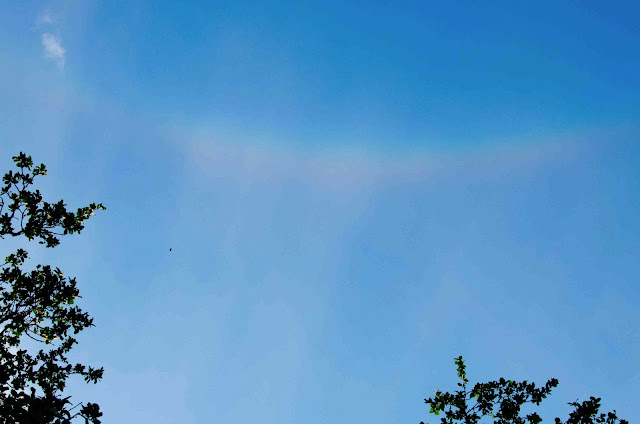Our martins. They came back. I just knew they'd leave today and never return. But they proved me wrong. Yet again.
This evening, I was going to put in a sparrow trap. Since today was perhaps a hatching day, I took some photos of the martins' nest. No eggs showed up. I took another picture, then another. No eggs. Tentatively, I reached inside the compartment and softly touched around the leaves. No eggs.
Gone.
Vanished.
I was stunned. James reached inside, too, and felt around. He couldn't believe it. "Four eggs," he said, "gone."
Sadly, I cleaned out the sparrow nests from two other compartments and threw the material on the ground. I didn't feel like putting in a trap. Then I went back inside the house and shared my sad news on the Purple Martin Conservation Association's page on Facebook.
"No eggs," I wrote. "Our four eggs are gone. The first would have been hatching around today. And we'd just put up the predator guard this week. And this morning, I just paid my dues to the PMCA and the North Texas Purple Martin group...our brand new colony is done. Finished. I feel so sad for the martins too."
Then I cried.
"I don't think I can do this any more," I typed on the page. ".....sorry.......I'm really down right now..................."
 I really felt like giving up on this business of being a purple martin landlord. Obviously, we'd failed. Because their eggs were gone. Likely eaten by a rat snake. We'd even met up with one in the back yard yesterday. James got pictures of it, too. We didn't think anything about it. We like snakes. But now... It's such a moral dilemma for me. Because of the martins, I trap sparrows (then give them to my Hit Man for execution). I appreciate the role that snakes play in nature, and I've never hated or feared them. But now, what do I do? It's hard. We have decided to get rid of two brush piles on our property. We'd let them pile up as "snags" and places that wildlife could hide. But now we wonder if that was wise after all. Maybe the rat snakes live there.
This evening, I stood in The Meadow, amazed and stunned to see our martin pair flying around the house. I'd just assumed that they would abandon their nest if a snake had indeed eaten their eggs. But there they were, flitting around and landing on their porch. At first, he sat and chortled a bit sadly. I wanted to cry. "I'm sorry," I said. "I'm so sorry you lost your eggs."
I really felt like giving up on this business of being a purple martin landlord. Obviously, we'd failed. Because their eggs were gone. Likely eaten by a rat snake. We'd even met up with one in the back yard yesterday. James got pictures of it, too. We didn't think anything about it. We like snakes. But now... It's such a moral dilemma for me. Because of the martins, I trap sparrows (then give them to my Hit Man for execution). I appreciate the role that snakes play in nature, and I've never hated or feared them. But now, what do I do? It's hard. We have decided to get rid of two brush piles on our property. We'd let them pile up as "snags" and places that wildlife could hide. But now we wonder if that was wise after all. Maybe the rat snakes live there.
This evening, I stood in The Meadow, amazed and stunned to see our martin pair flying around the house. I'd just assumed that they would abandon their nest if a snake had indeed eaten their eggs. But there they were, flitting around and landing on their porch. At first, he sat and chortled a bit sadly. I wanted to cry. "I'm sorry," I said. "I'm so sorry you lost your eggs."
But after awhile, he perked up and seemed happier. He'd take off, and she'd follow behind. They'd land on their porch, pop inside their compartment and chatter softly. Then they'd take off again. In and out, in and out.
So, if you're not going to give up, then I guess I can't either. Then I thought back on everything we've been through together. A first lady mate that didn't stay. A starling attack. Sparrow invasions. The day I thought a hawk had taken the male. And now the loss of four eggs.
Yet there they were, my martin male and female, going back inside the compartment where they'd lost their unhatched. How brave is that?
Truly, how brave IS that? I've decided that I'm going to try to have the courage of a purple martin.



























































